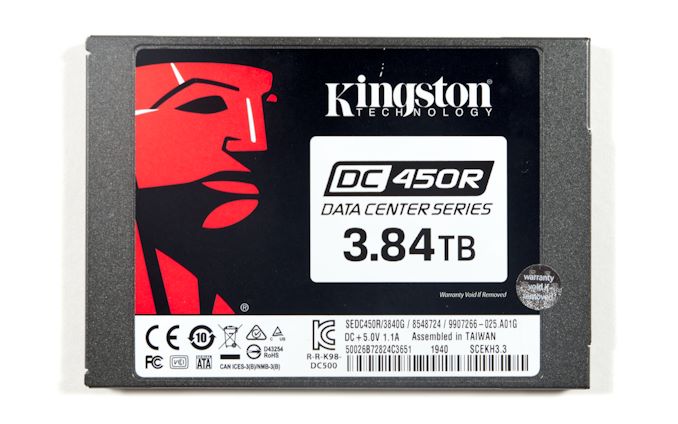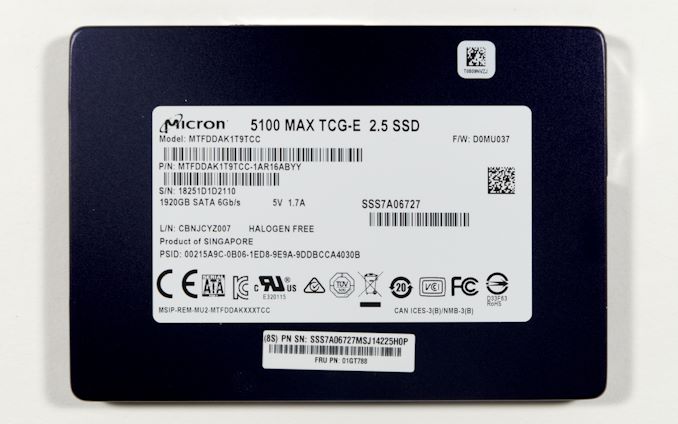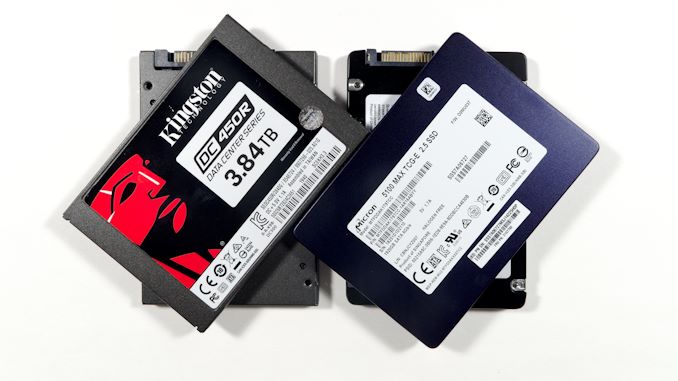Enterprise SATA SSDs: Can Budget 2020 beat Top Line 2017?
by Billy Tallis on February 4, 2020 11:00 AM ESTConclusion
Kingston's new DC450R rounds out their stack of enterprise SATA SSDs with a more budget-oriented entry level model. It's meant for heavily read-oriented workloads and handles them well, but it also offers good peak write performance that holds up for quite a while before dropping down to steady state. The big caveat is that it does not include power loss protection, a feature that's usually standard on enterprise SSDs. There's a growing number of entry-level drives that target this niche, but buyers do need to beware and ensure their intended use case does not require PLP.
The DC450R inherits a lot of characteristics from their existing DC500 series, since they share the same Phison S12DC controller. These drives have no trouble saturating the SATA link and offering decent QoS for the intended workloads, but Samsung's competitors consistently have better power efficiency and usually also superior QoS.
The Micron 5100 MAX is a relic of days gone by; few vendors make SATA SSDs like this any more, and when they do they are expensive niche products. The 5100 uses older, slower 3D TLC NAND and that holds it back in a few performance tests—especially latency metrics. But the excessive overprovisioning of this MAX variant allows it to overcome the handicap of slower NAND and deliver throughput that matches the best of today's enterprise SATA drives. The 5100 MAX also owes much of its staying power to the fact that the SATA bottleneck has not moved at all, and by 2017 even some TLC drives could hit that limit on a sustained write workload. Without that performance ceiling, there's little reason to expect 2-3TB of current-generation 3D TLC to perform the same as such an old drive.
The power efficiency of the 5100 MAX is also surprisingly competitive. Micron's first-generation 3D NAND was slow but didn't require too much power, and the controller used by the 5100 was also popular for consumer SSDs destined for battery-powered systems. Since that combination is still able to compete on performance against much newer drives, the low power consumption leads to decent power efficiency—though not as good as the Samsung drives.
Just about any enterprise NVMe SSD will blow all these SATA drives away when it comes to performance on more read-oriented workloads. For more write-heavy workloads, the NAND flash is more often the bottleneck and NVMe drives have a much smaller advantage, or none at all for lower-capacity and low-endurance models. This is where the Micron 5100 MAX really still shines; entry-level enterprise NVMe SSDs usually don't have enough overprovisioning to sustain the random write speeds the 5100 MAX provides.
| 480 GB | 960 GB | 1.92 TB | 3.84 TB | |
| Kingston DC450R | $150.21 (16¢/GB) |
$275.42 (14¢/GB) |
$518.09 (13¢/GB) |
|
| Kingston DC500R | $105.80 (22¢/GB) |
$166.31 (17¢/GB) |
$317.52 (17¢/GB) |
$601.80 (16¢/GB) |
| Kingston DC500M | $118.57 (25¢/GB) |
$218.38 (23¢/GB) |
$407.41 (21¢/GB) |
$749.01 (20¢/GB) |
| Micron 5100 MAX | $299.99 (16¢/GB) |
|||
| Samsung 860 DCT | $182.44 (19¢/GB) |
$331.04 (17¢/GB) |
$687.75 (18¢/GB) |
|
| Samsung 883 DCT | $119.99 (25¢/GB) |
$206.39 (21¢/GB) |
$365.95 (19¢/GB) |
$650.99 (17¢/GB) |
Judging the affordability of server SSDs is always difficult because retail sales are never the primary distribution channel. When a drive can be bought on Amazon or Newegg, it's usually through a third-party seller. Capacity selection and stock is often limited, as is the case with the Micron 5100 MAX being sold by MyDigitalDiscount. The prices we see can be very different from what bulk purchasers see. But right now, Kingston and Samsung have product lines that include retail distribution as part of the official business model, and we can make reasonable comparisons about relative prices even if we cannot directly analyze the bulk pricing that large business customers pay.
The Kingston DC450R seems to slot in nicely below the DC500R, which already undercuts the largely inferior Samsung 860 DCT. But at lower capacities, the DC450R either has limited availability or isn't much cheaper than the DC500R. Overall, Kingston's three models seem well-positioned to compete with Samsung's SATA options.
While supplies last, the 1.92 TB Micron 5100 MAX from MyDigitalDiscount is pretty good deal, currently about 18% cheaper than the Samsung 883 DCT. For read-heavy workloads it's only a little bit slower than the Samsung, and for very write-heavy workloads it can't be beat by any current SATA drive.













20 Comments
View All Comments
romrunning - Tuesday, February 4, 2020 - link
I understand the reason (batch of excess drives leftover from OEM) for using the Micro 5100 MAX, but for "enterprise" SSD use, I really would have liked to see Intel's DC-series (DC = Data Center) of enterprise SSDs compared.DanNeely - Tuesday, February 4, 2020 - link
This is a new benchmark suite, which means all the drives Billy has will need to be re-ran through it to get fresh numbers which is why the comparison selection is so limited. More drives will come in as they're retested; but looking at the bench SSD 2018 data it looks like the only enterprise SSDs Intel has sampled are Optanes.Billy Tallis - Tuesday, February 4, 2020 - link
This review was specifically to get the SATA drives out of the way. I also have 9 new enterprise NVMe drives to be included in one or two upcoming reviews, and that's where I'll include the fresh results for drives I've already reviewed like the Intel P4510, Optane P4800X and Memblaze PBlaze5.I started benchmarking drives with the new test suite at the end of November, and kept the testbed busy around the clock until the day before I left for CES.
romrunning - Wednesday, February 5, 2020 - link
I appreciate getting more enterprise storage reviews! Not enough of them, especially for those times when you might have some leeway on which storage to choose.pandemonium - Wednesday, February 5, 2020 - link
Agreed. I'm curious how my old pseudo enterprise Intel 750 would compare here.Scipio Africanus - Tuesday, February 4, 2020 - link
I love those old stock enterprise drives. Before I went NVME just a few months ago, my primary drive was a Samsung SM863 960gb which was a pumped up high endrance 850 Pro.shodanshok - Wednesday, February 5, 2020 - link
Hi Billy, thank for the review. I always appreciate similar article.That said, this review really fails to take into account the true difference between the listed enterprise disks, and this is due to a general misunderstanding on what powerloss protection does and why it is important.
In the introduction, you state that powerloss protection is a data integrity features. While nominally true, the real added value of powerloss protection is much higher performance for synchronized write workloads (ie: SQL databases, filesystem metadata update, virtual machines, etc). Even disks *without* powerloss protection can give perfect data integrity: this is achieved with flush/fsync (on application/OS side) and SATA write barrier/FUAs. Applications which do not use fsync will be unreliable even on drive featuring powerloss protection, as any write will be cached in the OS cache for a relatively long time (~1s on Windows, ~30s on Linux), unless opening the file in direct/unbuffered mode.
Problem is, synchronous writes are *really* expensive and slow, even for flash-backed drive. I have the OEM version of a fast M.2 Samsung 960 EVO NVMe drive and in 4k sync writes it show only ~300 IOPs. For unsynched, direct writes (ie: bypassing OS cache but using its internal DRAM buffer), it has 1000x the IOPs. To be fast, flash really needs write coalescing. Avoiding that (via SATA flushes) really wreack havok on the drive performance.
Obviously, not all writes need to be synchronous: most use cases can tolerate a very low data loss window. However, for application were data integrity and durability are paramount (as SQL databases), sync writes are absolutely necessary. In these cases, powerloss protected SSD will have performance one (or more) order of magnitude higher than consumer disks: having a non-volatile DRAM cache (thank to power capacitors), they will simply *ignore* SATA flushes. This enable write aggregation/coalescing and the relative very high performance advantage.
In short: if faced with a SQL or VM workload, the Kingston DC450R will fare very poorly, while the Micron 5100 MAX (or even the DC500R) will be much faster. This is fine: the DC450R is a read-intensive drive, not intended for SQL workloads. However, this review (which put it against powerloss protected drives) fails to account for that key difference.
mgiammarco - Thursday, February 6, 2020 - link
I agree perfectly finally someone that explains the real importance of power loss protection. Frankly speaking an "enterprise ssd" without plp and with low write endurance is really should be called "enterprise"? Which is the difference with a standard sdd?AntonErtl - Wednesday, February 5, 2020 - link
There is a difference between data integrity and persistency, but power-loss protection is needed for either.Data integrity is when your data is not corrupted if the system fails, e.g., from a poweroff; this needs the software (in particular the data base system and/or file system) to request the writes in the right order), but it also needs the hardware to not reorder the writes, at least as far as the persistent state is concerned. Drives without power-loss protection tend not to give guarantees in this area; some guarantee that they will not damage data written long ago (which other drives may do when they consilidate the still-living data in an erase block), but that's not enough for data integrity.
Persistency is when the data is at least as up-to-date as when your last request for persistency (e.g., fsync) was completed. That's often needed in server applications; e.g., when a customer books something, the data should be in persistent storage before the server sends out the booking data to the customer.
shodanshok - Wednesday, February 5, 2020 - link
fsync(), write barrier and SATA flushes/FUAs put strong guarantee on data integrity and durability even *without* powerloss protected drive cache. So, even a "serious" database running on any reliable disk (ie: one not lying about flushes) will be 100% functional/safe; however, performance will tank.A drive with powerloss protected cache will give much higher performance but, if the application is correctly using fsync() and the OS supports write barrier, no added integrity/durability capability.
Regarding write reordering: write barrier explicitly avoid that.